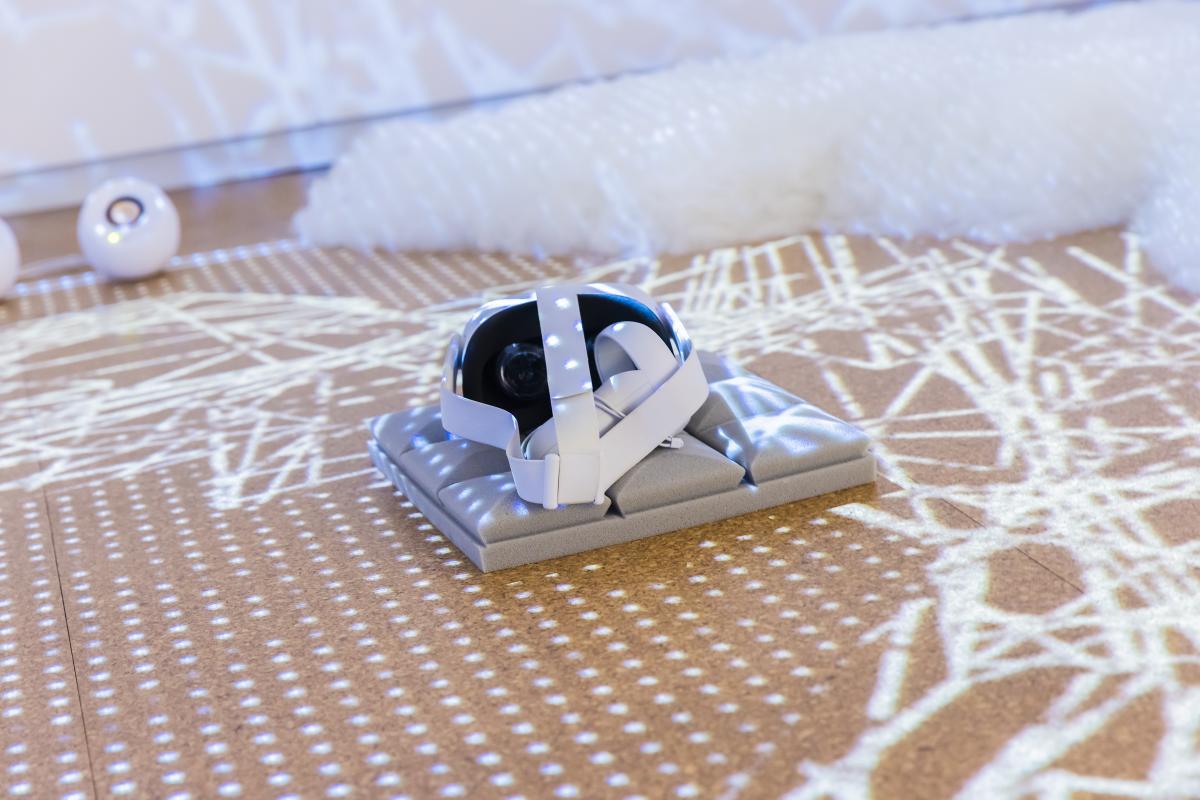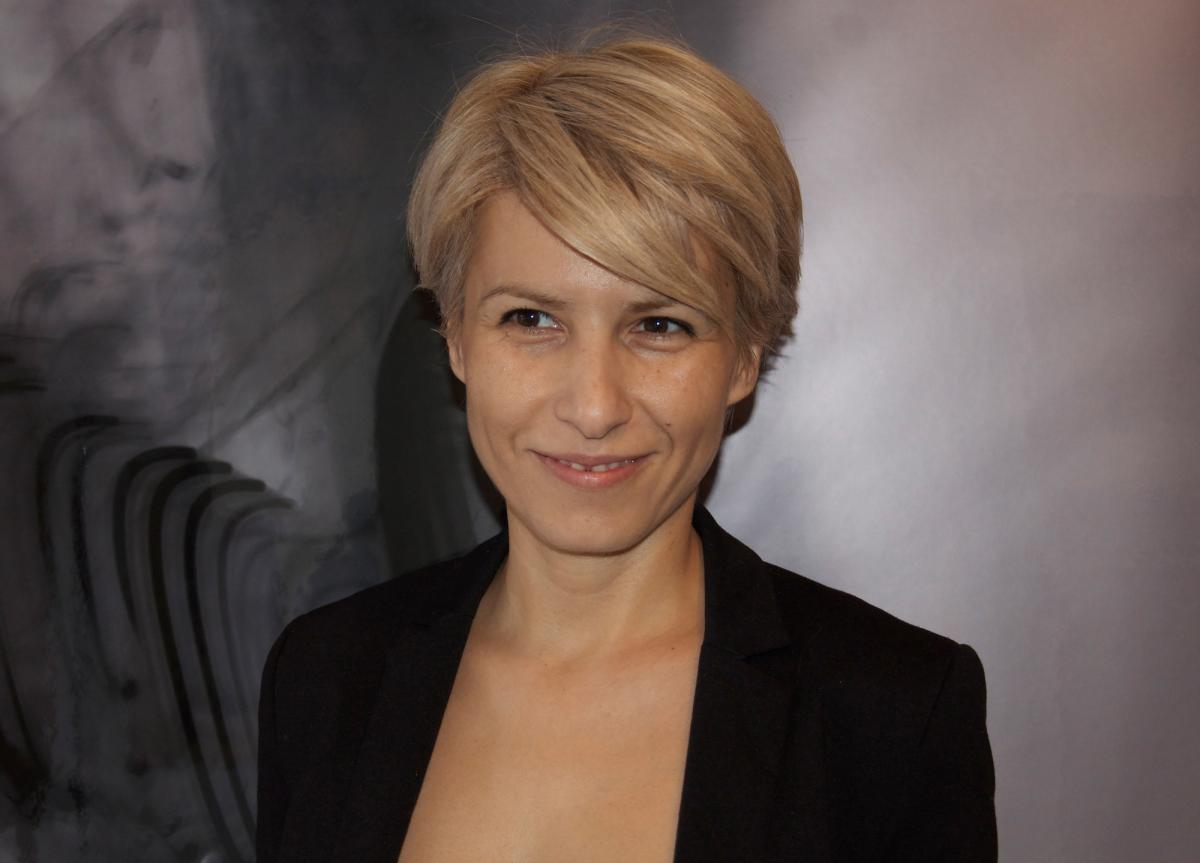Science of Happiness harnesses the newest medical research on specific frequencies of light, sound, and rhythm, resulting in the creation of physical and virtual spaces that enhance mental wellness and promote longevity.
This work is a reaction to the past years’ global health crisis, political anxieties, and human rights violations. The work aims to reinstall a sense of hope, joy, peace, and wellbeing through the interactive relationship between art and viewers.

At the heart of this work is an immersive video, VR, and fiber installation, utilizing specific frequencies of light, sound, and movement that improve the state of physical and mental health. Imagining future landscapes with digital technologies synchronized with nature is the aim of this phygital installation. Phygital is that which comprises both physical and digital elements and experiences. The therapeutic installation is both: protein and pixel, animal and artificial intelligence.
The work reflects the underlaying concept of what it means to be human in the age of unprecedented expansions of digital and biotechnologies.


Light and color
13.5 billion years old, light is the oldest material we know of. Through-out millions of years of evolution, the human eye developed the ability to distinguish close to one million different colors. Human societies across the Earth used colors as powerful cultural and spiritual signifiers. Certain hues were believed to have specific healing properties, especially in rich eastern traditions. Colors affect our mood, our perception, and have been used by artists in various mediums since the beginning of our species. In the 21st century, our sources of light become in part digital, as screens, video projectors, and most recently, virtual headsets. Science of Happiness, incorporates digital light sources, shining specific hues recommended by the newest discoveries in chromotherapy. Recent research shows that certain wavelengths of white spectrum stimulate the production of antioxidants in our body, while parts of the deep purple and violet spectrum can repair enzymes inside of our cells. Furthermore, color psychology recommends white for signaling purity and innocence, and purple for prosperity, wisdom, and spirituality.
Organic fiber
Islands of translucent organic fiber create a cocoon-like landscape onto which videos are projected, enhancing the softness of the space, and the atmosphere of peace and relaxation. The fiber is sheep's wool, which consists of the protein Keratin, the same protein humans have in their skin, hair, and nails. The sheep’s wool is a material we clothed ourselves in for 8,000 years, effectively becoming an extension to our skin. Created by men, through techniques of selective breeding, wool is one of the best examples of early bioengineering. Approved by nature, this material is still praised for its beneficial properties: temperature, moisture, and sound insulation, as well as natural antibacterial properties. As the first mammal to be cloned, sheep continues to be a species closely associated with traditional and contemporary biotechnological advances.
Sound and rhythm
Just as with color, sound affects our mood and our perception. Music is a powerful medium influencing our body, our mind, and what we traditionally call our soul. Frequencies of sound used for the installation enhance an overall relaxing and ethereal mood. The rhythm of deep, meditative breathing, proven to calm our minds, informs the pace of Sound and rhythm. Just as with color, sound affects our mood and our perception. Music is a powerful medium influencing our body, our mind, and what we traditionally call our soul. Frequencies of sound used for the installation enhance an overall relaxing and ethereal mood. The rhythm of deep, meditative breathing, proven to calm our minds, informs the pace of moving projections. The immersion into reduced speeds and soothing tones make us pause, breathe slower, and concentrate.
Accessibility
The site-specific installation for the Georgia Institute for Technology is mindfully designed to welcome all who would like to experience it, regardless of their abilities. The installation has floor sitting stations, and a central space designed for a wheelchair to comfortably enter and turn 360 degrees. For visitors not able to sit on the floor, a chair will be available on site to assure their comfort.
Healthcare is a human right
According to CDC’s National Health Statistics Report in 2020, over 31 million people in United States were uninsured, and 3.7 million of those uninsured were children. This is an urgent issue that we need to act on together. As citizens, we can all be politically active until every single American has affordable health and dental care. Science of Happiness aims to create a space where we can feel joy and peace, improving our sense of wellness, free of charge.
Sustainability
Recycling and sustainability are at the core of Bojana Ginn Studio’s art practice. Immersive installations and video-sculptures are built with sheep’s wool, energy saving LED lights, and ephemeral light projections. Sheep’s wool is an all-natural, carbon capturing, sustainable, recyclable, and completely biodegradable material. This material is purchased from small farms across the United States.

About the Artist
Award-winning interdisciplinary artist, former medical doctor and scientist, Dr. Bojana Ginn works at the intersection of art, science, and technology.
Ginn is a recipient of the Ellsworth Kelly Award, granted by the Foundation for Contemporary Art in New York. Finalist for the World Technology Award in Art, Ginn is a fellow at The World Technology Network, New York. Her work has been exhibited at the Venice Architectural Biennale, Museum of Art and Design in New York, Espronceda Institute of Art and Culture in Barcelona, Museum of Contemporary Art of Georgia in Atlanta, David J. Sencer CDC Museum in Atlanta, Cyber Center in Augusta, GA, and many others.

